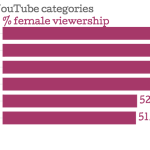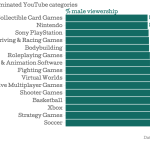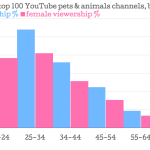Get honest, in-depth coverage of media, marketing and TV, delivered to your inbox daily. Sign up for the Digiday Daily Newsletter here.
With over 300 hours of videos uploaded a minute, YouTube has something for everyone.
While it attracts an even split of women and men, YouTube is still fairly male dominated. Men spend 44 percent more time on the site per month, and of 51 categories of YouTube content measured by OpenSlate, men make up the majority of viewers in 90 percent of them. If you’re looking for stereotypes to bust, YouTube isn’t the place. Women are into makeup and skin care; men are into sports and gaming. What bridges the gender divide: dogs — well, and East Asian music.
On the dude side, well, it’s testosterone with a heavy dose of nerd.
“As soon as you omit gaming as a macro category, it goes to almost 50-50,” said Mike Henry, CEO of Outrigger Media, which operates Openslate. “Guys spend an incredible amount of time watching gaming videos.”
Beyond gender, YouTube has an age divide. Now a decade old, it is mainstream enough to have a broad demographic reach. Even the olds watch video, although not to the degree of millennials.
In aggregate, YouTube has a huge audience, reaching 81.2 percent of Internet users in the U.S., according to comScore data. Unsurprisingly, younger visitors tend to spend more time on the site. In March, YouTube drew 31.8 million users aged 18 to 24 (98.3 percent of U.S. Internet users in that age bracket) who spent an average of 10 hours, 15 minutes on the site. Meanwhile, the platform attracted 19.4 million visitors 65 and older (74.4 percent of Internet users in that demo) who spent an average of 3 hours, 54 minutes using the video-streaming service.
For YouTube advertisers, buying beauty and style channels through Google Preferred — which bundles the top 5 percent of YouTube channels in any given vertical for ad buys — is a good bet to reliably reach women, particularly young teens and millennials. Beauty and style is a popular category, with 582 million monthly views across its top 100 channels, according to OpenSlate.
And those channels attract a youthful, largely female crowd: 17.2 percent of viewers are girls ages 13-17, 39.9 percent are women 18-24, and 16.9 are women 25-34. The most popular YouTuber in the space is Mariand Castrejon, also known as “Yuya,” a high-pitched Mexican vlogger whose Spanish-language makeup and style tutorial videos rack up 41 million views each month.
But there is one thing that unites us all: pets. Videos featuring pets and animals have a more even gender split. Animal videos attract viewers of all ages, but the top 100 channels in the category (which collectively generate 259 million monthly views) are most popular among millennial men (18-34), who account for 30 percent of viewership. In contrast, millennial women represent around 24 percent of viewership in the category.
“Understanding who is watching what at a really granular level is where the storytelling process starts,” said Outrigger’s Henry. “You can always find these people and target them, but it’s a completely different value proposition if you can target them in the mindset they’re in with a message that fits.”
For more research, interviews and analysis from the world of video, sign up to our weekly video briefing email.
Main image courtesy of Ververidis Vasilis / Shutterstock
More in Media

Publishers revamp their newsletter offerings to engage audiences amid threat of AI and declining referral traffic
Publishers like Axios, Eater, the Guardian, theSkimm and Snopes are either growing or revamping their newsletter offerings to engage audiences as a wave of generative AI advancements increases the need for original content and referral traffic declines push publishers to find alternative ways to reach readers.

The Guardian US is starting its pursuit of political ad dollars
The Guardian US is entering the race for political ad dollars.

How much is Possible’s future in Michael Kassan’s hands?
Some people in the know at Possible said they see the conference taking a bite out of Cannes’ attendance, most acutely by U.S.-based marketers who could save money by staying on this side of the Atlantic.










